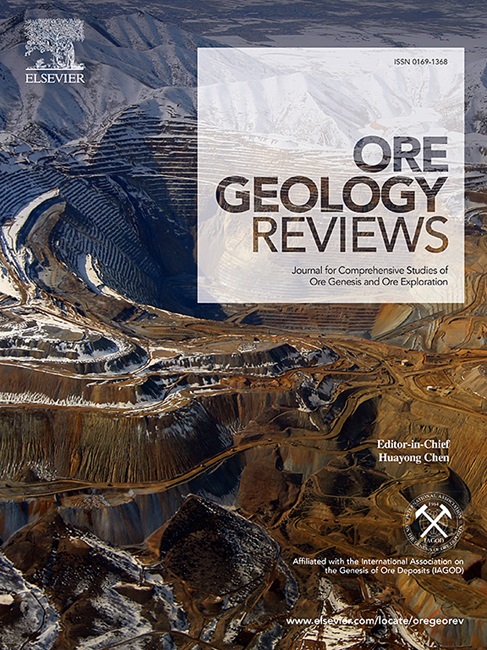Genesis of Early-Cambrian barite deposits in the southeastern margin of the Yangtze Platform
IF 3.2
2区 地球科学
Q1 GEOLOGY
引用次数: 0
Abstract
The Tianzhu barite deposit in Guizhou, South China, is the world’s largest barite deposit, hosted within the chert of the Lower Cambrian Liuchapo Formation. Its genesis has long been debated, with proposed models suggesting either submarine hydrothermal or cold-seep origins. To clarify its formation process, comprehensive mineralogical, sedimentological, paleontological, and geochemical analyses were conducted. The deposit exhibits distinct vertical zoning, including columnar and pie-like barite at the base, massive and granophyric barite in the middle, laminar and banded barite at the top, associated with barite nodules, hyalophane and small-shell fossils. Trace element data, along with sulfur, carbon, oxygen, and silicon isotope compositions, suggest that the Tianzhu barite deposit is unlikely to have formed through submarine hydrothermal processes. Instead, it primarily precipitated in confined basins in a shallow-water, oxidizing environment. Ba-rich fluids erupted along faults near ancient islands and accumulated in these basins. During transgressions, deep-sea sulfate ions mixed with Ba-rich fluids, triggering extensive barite precipitation. In later stages, sulfate depletion in seawater facilitated hyalophane formation at the uppermost layers. These findings provide new insights into the genesis of the Tianzhu barite deposit and suggest that large-scale barite precipitation played a significant role in reducing toxic Ba concentrations in Cambrian oceans, potentially contributing to the Cambrian explosion.

扬子地台东南缘早寒武世重晶石矿床成因
天柱重晶石矿床位于中国南部贵州,是世界上最大的重晶石矿床,赋存于下寒武统柳滩组的燧石岩中。它的起源长期以来一直存在争议,提出的模型表明要么是海底热液,要么是冷渗漏。为明确其形成过程,对其进行了矿物学、沉积学、古生物学、地球化学等综合分析。矿床纵向分带明显,底部为柱状和饼状重晶石,中部为块状和花岗状重晶石,顶部为层状和带状重晶石,并伴有重晶石结核、透明石和小壳化石。微量元素数据以及硫、碳、氧和硅同位素组成表明,天柱重晶石矿床不太可能是通过海底热液作用形成的。相反,它主要在浅水氧化环境的封闭盆地中沉淀。富钡流体沿着古岛屿附近的断层喷发,并在这些盆地中积聚。海侵过程中,深海硫酸盐离子与富钡流体混合,引发大量重晶石沉淀。在后期,海水中硫酸盐的枯竭促进了最上层透明玻璃的形成。这些发现为天柱重晶石矿床的成因提供了新的见解,并表明大规模重晶石降水在降低寒武纪海洋中有毒Ba浓度方面发挥了重要作用,可能是寒武纪大爆发的原因之一。
本文章由计算机程序翻译,如有差异,请以英文原文为准。
求助全文
约1分钟内获得全文
求助全文
来源期刊

Ore Geology Reviews
地学-地质学
CiteScore
6.50
自引率
27.30%
发文量
546
审稿时长
22.9 weeks
期刊介绍:
Ore Geology Reviews aims to familiarize all earth scientists with recent advances in a number of interconnected disciplines related to the study of, and search for, ore deposits. The reviews range from brief to longer contributions, but the journal preferentially publishes manuscripts that fill the niche between the commonly shorter journal articles and the comprehensive book coverages, and thus has a special appeal to many authors and readers.
 求助内容:
求助内容: 应助结果提醒方式:
应助结果提醒方式:


